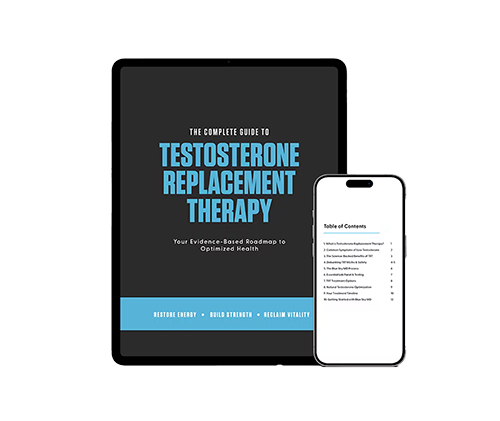Testosterone plays a crucial role in many aspects of health (especially for men). However, not all testosterone in the body is created equal.
When you get your levels checked, your results may show total testosterone, free testosterone, or both. So what’s the difference, and which one actually matters more?
Understanding the distinction between these two can give you a better idea of your overall hormonal health, symptoms, and the effectiveness of any treatment you’re undergoing, like testosterone replacement therapy.
What Is Total Testosterone?
Total testosterone refers to the overall amount of testosterone circulating in your blood. This includes:
- Free testosterone: The small fraction (1–3%) that is unbound and available to enter cells and activate receptors.
- Testosterone bound to SHBG (sex hormone-binding globulin): This form is tightly bound and not readily usable by the body.
- Testosterone bound to albumin: This is loosely bound and may be available for use, though not as freely as unbound testosterone.
Total testosterone provides a general snapshot of how much testosterone your body is producing, but it doesn’t tell the full story about how much of that hormone is actually bioavailable and active in your tissues.
What Is Free Testosterone?
Free testosterone is the form of testosterone that is not bound to proteins like SHBG or albumin. It is the active form that can easily enter cells and exert its effects, including:
- Supporting muscle mass
- Regulating libido and sexual function
- Influencing mood and mental clarity
- Supporting red blood cell production and bone density
Even if your total testosterone levels are “normal,” low free testosterone can cause symptoms of deficiency.
Why Understanding the Difference Matters
1. Diagnosing Low T
Many men experience symptoms of low testosterone like fatigue, low libido, depression, and weight gain even when their total testosterone appears to be within the normal range.
In these cases, testing free testosterone provides a more accurate picture of whether you’re truly deficient in bioavailable testosterone.
2. Impact of SHBG
Levels of sex hormone-binding globulin (SHBG) can vary due to age, medications, liver health, thyroid function, and other factors. Higher SHBG levels bind more testosterone, leaving less free and active in the body.
Someone with high SHBG levels might have high total testosterone but low free testosterone, which could explain the persistence of symptoms despite “normal labs.”
For those curious, we explore SHGB in more depth in this article here.
3. Treatment Decisions
Free testosterone is often used to guide testosterone replacement therapy treatment plans. If your total T is borderline but your free T is low, your provider may still recommend treatment.
Likewise, monitoring both during TRT ensures you’re getting the right dose—not too little, and not too much.
Start With the Right Labs and a Personalized Treatment Plan
Your hormone health journey starts with a deeper look at what’s actually happening inside your body. Here at Blue Sky MD, we start with comprehensive baseline lab panel that evaluates all of the most essential hormones for energy, mood, metabolism, and libido.
This lab helps us measure both total testosterone and free testosterone to see how much of your testosterone is active and reaching your tissues.
We also assess:
- Estrogen: Crucial for mood stability, libido, and healthy fat distribution
- DHEA: A marker of stress resilience and sleep quality
- Thyroid Panel, including Free T4 and Free T3: To ensure your metabolism and hormone delivery systems are functioning properly
Results are typically available within 2 business days, giving you quick insight into your hormonal balance so that we can act quickly to resolve your symptoms.
Step 2: Initial Consultation & Same-Day Treatment
Once we have your labs, you’ll meet one-on-one with a provider to review symptoms, medical history, and discuss any prior hormone therapies you’ve tried.
We’ll also help you determine which delivery method works best for you, whether it be bio-identical hormone pellets, injections, creams, etc.
Based on your results, we’ll customize a treatment plan that fits your lifestyle, often allowing us to start your first treatment that same day.
Step 3: Receive Your Treatment & Start Feeling Better
Once treatment begins, we’ll schedule a follow-up in about 4 weeks to ensure your symptoms are resolving and hormone levels are improving and make adjustments as necessary.
Most patients feel up to 80% better within the first week, with full symptom relief often arriving in 3–4 weeks.
Total testosterone vs free testosterone: The bottom line
Let’s recap: when it comes to understanding your testosterone levels, free testosterone is often a more relevant indicator of how well your hormones are functioning, while total testosterone is only part of the picture.
Ultimately, a more comprehensive approach to lab testing is the key to getting you feeling better sooner.
If you’re experiencing symptoms of low testosterone, regardless of your lab results, contact us today to schedule a comprehensive lab panel to evaluate total vs free testosterone, as well as SHBG, to get the most accurate diagnosis and create a treatment plan tailored to your needs.
FREQUENTLY ASKED QUESTIONS
Total testosterone is the overall amount of testosterone in your blood, including both bound and unbound forms. Free testosterone makes up only a small percentage of this total, but it is the active form that can enter your cells and do the work of testosterone, like supporting energy, libido, muscle mass, and mood.
Because free testosterone is the form your body actually uses. You can have “normal” total testosterone but still have low free testosterone due to high SHBG (sex hormone-binding globulin), which binds testosterone and makes it inactive. If you’re experiencing symptoms of low T, you must measure both to understand the full picture.
The best way is to start with a comprehensive lab panel that includes total testosterone, free testosterone, estrogen, DHEA, and thyroid markers. If your free testosterone is low and you’re experiencing symptoms like fatigue, low libido, weight gain, or depression, TRT may be a good option.
Common symptoms of low free Testosterone include:
-
Low sex drive
-
Fatigue or lack of motivation
-
Mood swings or irritability
-
Increased body fat
-
Decreased muscle mass or strength
-
Brain fog or difficulty concentrating
-
Poor sleep
Most patients report noticeable improvements within 1 week, with symptoms continuing to improve over the next 3–4 weeks. Full results typically take a few months, depending on your starting levels and how your body responds to treatment.
Our baseline hormone panel includes:
-
Total Testosterone
-
Free Testosterone
-
Estrogen
-
DHEA
-
Thyroid Panel (TSH, Free T3, Free T4)
This allows us to evaluate not just your testosterone, but the full hormonal picture to ensure optimal balance and results.
Lab results typically return within 2 business days, so you can move quickly from diagnosis to treatment if needed.
Yes! If you qualify for treatment based on your labs and medical history, we can often begin your first dose that same day during your provider consultation.
Absolutely. We schedule a follow-up about 4 weeks after your first treatment to reassess symptoms and recheck labs if needed. This ensures your dosage is dialed in and you’re on the path to optimal health.







